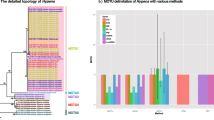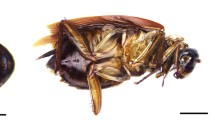Abstract
Invasive alien species constitute a substantial conservation challenge in the terrestrial sub-Antarctic. Management plans, for many of the islands in the region, call for the prevention, early detection, and management of such alien species. However, such management may be confounded by difficulties of identification of immatures, especially of holometabolous insects. Here we show how a DNA barcoding approach has helped to overcome such a problem associated with the likely establishment of an alien moth species on Marion Island. The discovery of unidentifiable immatures of a noctuid moth species, 5 km from the research station, suggested that a new moth species had colonized the island. Efforts to identify the larvae by conventional means or by rearing to the adult stage failed. However, sequencing of 617 bp of the mitochondrial cytochrome oxidase subunit I gene, and comparison of the sequence data with sequences on GENBANK and the barcoding of life database enabled us to identify the species as Agrotis ipsilon (Hufnagel), a species of which adults had previously been found regularly at the research station. Discovery of immatures of this species, some distance from the research station, suggests that a population may have established. It is recommended that steps to be taken to eradicate the species from Marion Island.

Similar content being viewed by others
References
Annecke DP, Moran VC (1982) Insects and mites of cultivated plants in South Africa. Butterworths, Durban
Armstrong KF, Ball SL (2005) DNA barcodes for biosecurity: invasive species identification. Philos Trans R Soc Lond B 360:1813–1823
Beck SD (1988) Cold acclimation of Agrotis ipsilon (Lepidoptera: Noctuidae). Ann Entomol Soc Am 81:964–968
Bergstrom D, Chown SL (1999) Life at the front: history, ecology and change on southern ocean islands. Trends Ecol Evol 14:472–477
Chown SL, McGeoch MA, Marshall DJ (2002) Diversity and conservation of invertebrates on the sub-Antarctic Prince Edward Islands. Afr Entomol 10:67–82
Chown SL, Slabber S, McGeoch MA, Janion C, Leinaas HP (2007) Phenotypic plasticity mediates climate change responses among invasive and indigenous arthropods. Proc Roy Soc Lond B 274:2531–2537
Convey P (2005) Recent lepidopteran records from sub-Antarctic South Georgia. Polar Biol 28:108–110
Crafford JE, Chown SL (1987) Plutella xylostella L. (Lepidoptera, Plutellidae) on Marion Island. J Entomol Soc S Afr 50:259–260
Crafford JE, Scholtz CH, Chown SL (1986) The insects of sub-Antarctic Marion and Prince Edward Islands; with a bibliography of entomology of the Kerguelen Biogeographical Province. S Afr J Antarct Res 16:41–84
de Villiers MS, Cooper J, Carmichael N, Glass JP, Liddle GM, McIvor E et al (2006) Conservation management at Southern Ocean Islands: towards the development of best-practice guidelines. Polarforschung 75:113–131
de Villiers MS, Cooper J (2008) Conservation and management. In: Chown SL, Froneman PW (eds) The Prince Edward Islands. Land-sea interactions in a changing ecosystem. Sun, Stellenbosch (in press)
Folmer O, Black M, Hoeh W, Lutz R, Vrijenhoek R (1994) DNA primers for amplification of mitochondrial cytochrome c oxidase subunit I from diverse metazoan invertebrates. Mol Mar Biol Biotechnol 3:294–299
Frenot Y, Chown SL, Whinam J, Selkirk PM, Convey P, Skotnicki M, Bergstrom DM (2005) Biological invasions in the Antarctic: extent, impacts and implications. Biol Rev 80:45–72
Greenslade P, Farrow RA, Smith JMB (1999) Long distance migration of insects to a subantarctic island. J Biogeogr 26:1161–1167
Hall TA (1999) BioEdit: a user-friendly biological sequence alignment editor and analysis program for Windows 95/98/NT. Nucl Acids Symp Ser 41:95–98
Hänel C, Chown SL, Davies L (1998) Records of alien insect species from sub-Antarctic Marion and South Georgia Islands. Afr Entomol 6:366–369
Hebert PDN, Cywinska A, Ball SL, de Waard JR (2003) Biological identifications through DNA barcodes. Proc Roy Soc Lond B 270:313–321
Lee JE, Slabber S, Jansen van Vuuren B, van Noort S, Chown SL (2007) Colonisation of sub-Antarctic Marion Island by a non-indigenous aphid parasitoid Aphidius matricariae (Hymenoptera, Braconidae). Polar Biol 30:1195–1201
Luckmann WH, Shaw JT, Sherrod DW, Ruesnick WG (1976) Developmental rate of the black cutworm. J Econ Entomol 69:386–388
Monaghan MT, Balke M, Pons J, Vogler AP (2006) Beyond barcodes: complex DNA taxonomy of a South Pacific Island radiation. Proc Roy Soc Lond B 273:887–893
Moritz C, Cicero C (2004) DNA barcoding: promise and pitfalls. PLoS Biol 2:1529–1531
Pyšek P, Richardson DM, Rejmánek M, Webster GL, Williamson M, Kirschner J (2004) Alien plants in checklists and floras: towards better communication between taxonomists and ecologists. Taxon 53:131–143
Rejmánek M, Richardson DM, Higgins SI, Pitcairn MJ, Grotkopp E (2005) Ecology of invasive plants: state of the art. In: Mooney HA, Mack RA, McNeely JA, Neville LE, Schei PJ, Waage JK (eds) Invasive alien species. A new synthesis. Island Press, Washington, pp 104–161
Rubinoff D (2006) Utility of mitochondrial DNA barcodes in species conservation. Conserv Biol 20:1026–1033
Scholtz CH, Holm E (1985) Insects of Southern Africa. Butterworths, Durban
Showers WB, Whitford F, Smelser RB, Keaster AJ, Robinson JF, Lopez JD, Taylor SE (1989) Direct evidence for meteorologically driven long-range dispersal of an economically important moth. Ecology 70:987–992
Sinclair BJ, Chown SL (2006) Catterpillars benefit from thermal ecosystem engineering by wandering albatrosses on sub-Antarctic Marion Island. Biol Lett 2:51–54
Slabber S, Chown SL (2005) Differential responses of thermal tolerance to acclimation in the sub-Antarctic rove beetle Halmaeusa atriceps. Physiol Entomol 30:195–204
Wittenberg R, Cock MJW (2005) Best practices for the prevention and management of invasive alien species. In: Mooney HA, Mack RA, McNeely JA, Neville LE, Schei PJ, Waage JK (eds) Invasive alien species. A new synthesis. Island Press, Washington, pp 209–232
Acknowledgments
We thank Richard Mercer for assistance in the field, Jennifer E. Lee, Philip Pugh, and two anonymous referees for comments on the manuscript, the South African National Antarctic Programme for logistic support, and the National Research Foundation for partial funding (SANAP Grant 2069543 to BJvV).
Author information
Authors and Affiliations
Corresponding author
Rights and permissions
About this article
Cite this article
Chown, S.L., Sinclair, B.J. & van Vuuren, B.J. DNA barcoding and the documentation of alien species establishment on sub-Antarctic Marion Island. Polar Biol 31, 651–655 (2008). https://doi.org/10.1007/s00300-007-0402-z
Received:
Revised:
Accepted:
Published:
Issue Date:
DOI: https://doi.org/10.1007/s00300-007-0402-z



